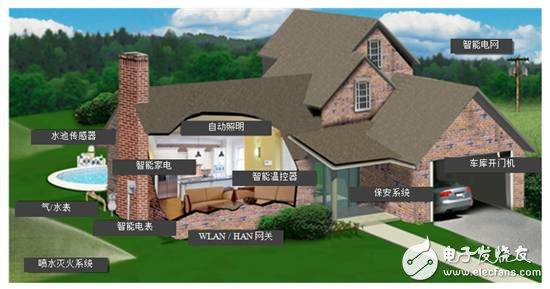Advances in wireless connectivity and low-power embedded processing technologies have provided new applications for smart homes and buildings. Of course, most smart home systems have a fixed-position control panel or base unit that can be plugged into an AC power system, but there may be distributed (and removable) wireless sensors or cameras that form part of the overall system. Peripherals are not always close to permanent power. Figure 1: Example of a smart home : a typical system with multiple remote peripherals and a central gateway (controller) Many of these wireless sensors or cameras will require frequent battery use and require periodic battery replacement, thus increasing maintenance costs. For these modular accessories, rechargeable batteries are becoming more and more popular. In some cases, the control panel unit is also equipped with a battery to provide backup power or an alarm in the event of an AC power failure. If you're developing a smart home system, you probably want to focus your work on system features rather than on the basic tasks of powering and recharging. Since lithium-ion batteries have become very popular in recent years, there are many options for dedicated charging IC solutions. For small batteries and low charging currents, cost-effective (and relatively easy to implement) linear chargers can be used, while high-performance peripherals (such as high-resolution cameras) may require larger capacity batteries to ensure long-term operation, which is This means more charging current is required, so this will require a switch mode charger, otherwise the heat generated due to power loss in the linear charger will be excessive. Many high current switch mode chargers require software control from the host processor, which requires additional engineering time. The benefit of these programmable chargers is the flexibility to adapt the circuit to different battery types and charging currents, while other switch mode chargers may require external power FETs or current sensing components to achieve variable charging current. How do you provide an adjustable, flexible solution for different battery types without investing in software development or laying out complex PCBs? The bq25606 charger works. As shown in the circuit below, it provides all the features needed for a typical single-cell battery charging and system power solution. The bq25606 uses several resistor values ​​to optimize charge current and battery terminal voltage. It also features built-in overvoltage protection to prevent power line or connection transients and automatically detect the available power to most standard USB power supplies. The input current limit and charge current can be adjusted through several simple external component selections and the battery voltage can be set (4.2V, 4.35V or 4.4V for a given battery type, as needed). Figure 2: bq25606 implementation schematic With the bq25606, you can optimize your charging current and voltage settings with a few simple component selections to get up and running in minutes! An electronic clock device with a wireless network monitoring camera is characterized in that it comprises an electronic clock device body with a wireless network monitoring camera; the electronic clock device body with a wireless network monitoring camera is composed of a foot, a wireless transmission module, a It consists of a rechargeable battery, a speaker, a touch display screen, a camera, a casing, an infrared device, and a microprocessor; the feet are fixedly installed at the bottom of the rechargeable battery; a casing is fixedly installed on the top of the rechargeable battery, and the The interior is provided with a touch screen, a camera, an infrared device and a microprocessor; the microprocessor is electrically connected to the rechargeable battery through wires; the wireless transmission module, speaker, display, camera and infrared device are connected to the micro processor through wires The display screen is arranged at the bottom of the camera, and the camera is surrounded by an infrared device; the wireless transmission module is fixedly installed on both sides of the rechargeable battery, and the speakers are opened on both sides of the casing Wifi Electronic Clock,Wifi Electronic Clock hidden camera,hidden camera wifi,hidden camera wireless,spy camera wifi Jingjiang Gisen Technology Co.,Ltd , https://www.gisentech.com
